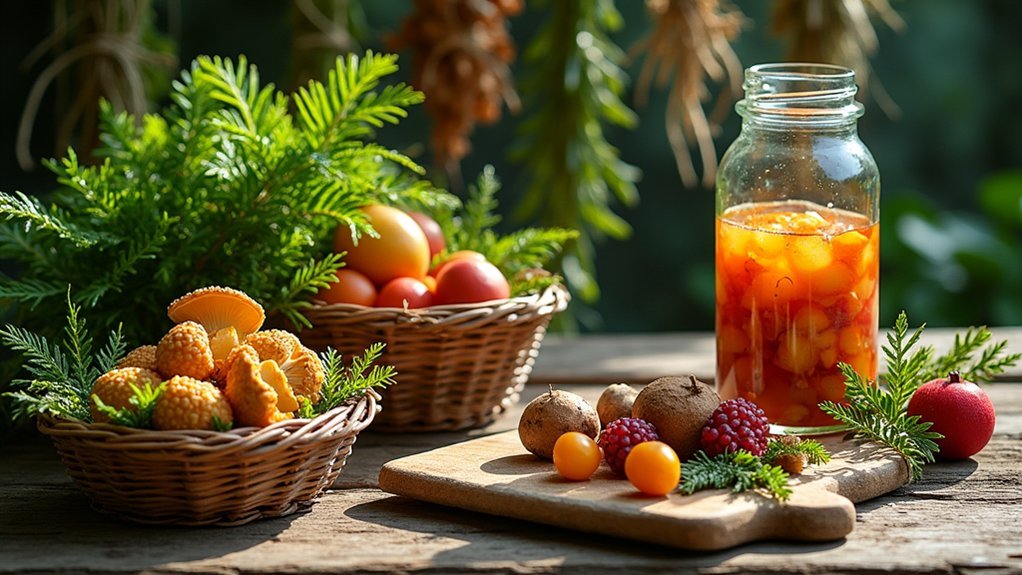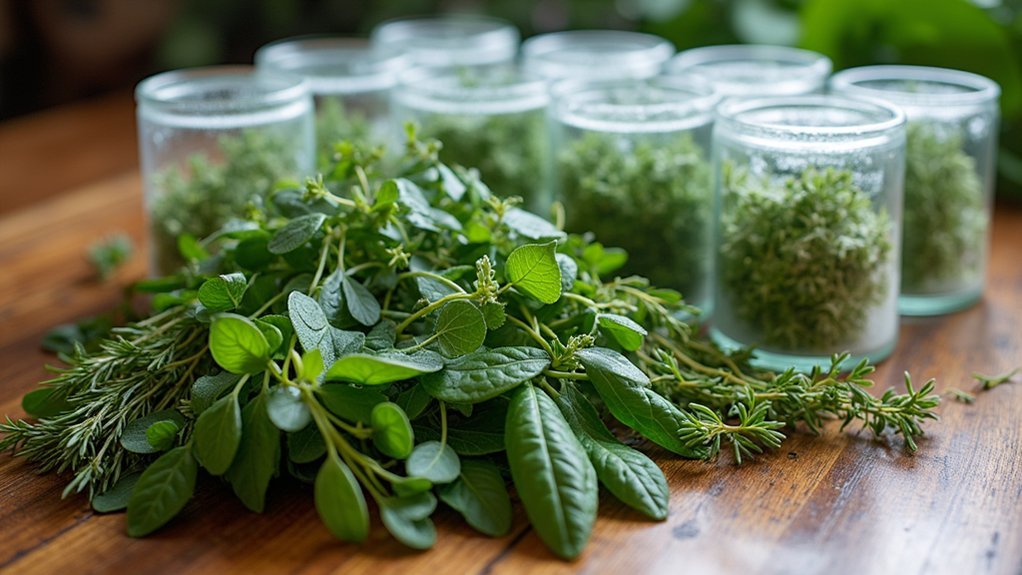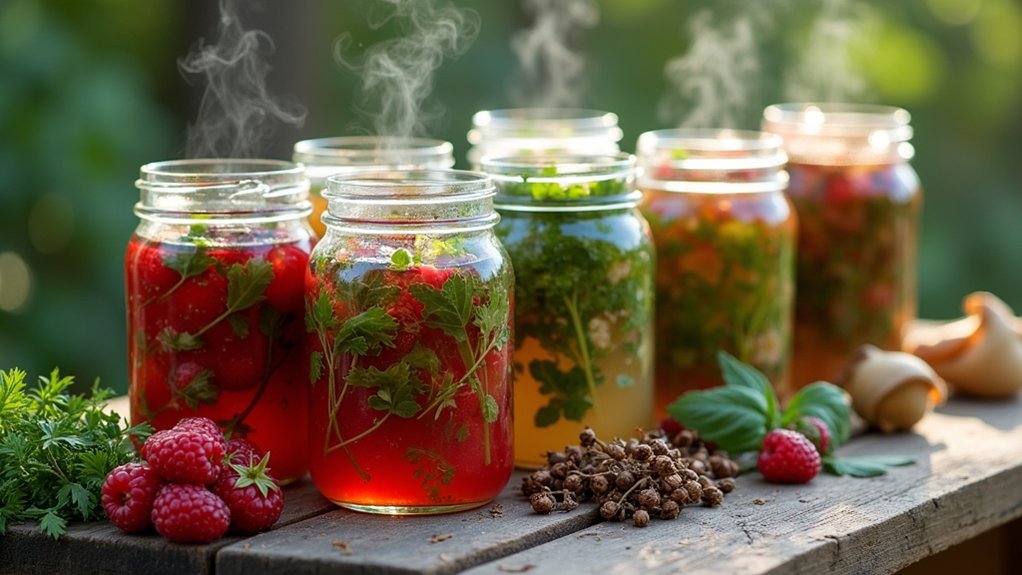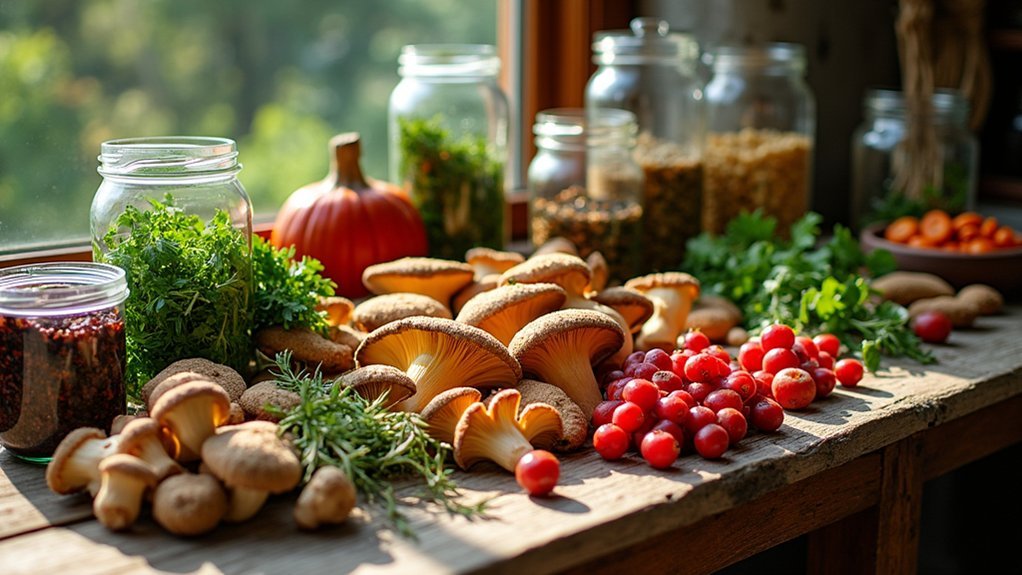Mastering preservation techniques transforms your seasonal foraging into a year-round food source. You'll maximize nutrition and minimize waste by blanching greens, freezing berries, drying herbs, and fermenting wild edibles. These methods extend shelf life from months to years while maintaining flavor and nutrients. Proper storage also helps you avoid contamination risks and guarantees safety. The difference between abundance and scarcity often lies in these essential preservation skills you're about to discover.
Essential Wild Food Preservation Basics

When you've collected an abundance of wild edibles from your foraging expeditions, knowing how to preserve them properly becomes essential for extending their usefulness.
The key to maintaining high quality lies in selecting the right storage methods based on each plant's characteristics.
Preserve your foraged treasures wisely by matching each wild edible with its ideal storage solution.
Blanching wild plants like lambs quarters preserves their color and texture before freezing. You'll need to quickly boil them, then cool in ice water. For freezing, use airtight containers to prevent freezer burn.
Drying, a traditional preservation technique, requires plants with sufficient dry matter content. You can air-dry naturally or use an oven or dehydrator for faster results.
Properly dried plants stored in mason jars or zip-lock bags away from heat and moisture will last one to two years.
Blanching Urban Foraged Greens
When blanching urban foraged greens like lambs quarters, you'll need the right salt-water balance—about one tablespoon per gallon of water—to preserve flavor and texture.
After your greens turn bright and tender (2-5 minutes), cool them immediately in ice water for the same duration to halt cooking and lock in nutrients.
Store your blanched greens in airtight freezer bags with excess air removed to prevent freezer burn and maintain quality for months.
Salt-Water Ratio Matters
Although many foragers focus on proper identification and collection techniques, the salt-water ratio during blanching proves equally vital for preserving your urban harvest.
For best results, use 1-2 tablespoons of salt per quart of boiling water when blanching your foraged greens.
This precise salt-water ratio doesn't just enhance flavor—it draws out excess moisture from your greens, a key step in preventing freezer burn during long-term storage.
After a quick 1-5 minute boil (depending on the green), immediately plunge them into ice water for the same duration to halt the cooking process.
When you've mastered the correct blanching technique, you'll enjoy high-quality preserved greens for up to 12 months in your freezer—extending your foraging bounty well beyond its natural season.
Cool Quickly, Store Properly
Once you've mastered the salt-water ratio, you'll need to focus on the cooling and storage phases of the blanching process.
Immediately after your greens have spent 2-3 minutes in boiling water, plunge them into ice water for the same duration. This critical step halts cooking, preserving both texture and nutrients.
When storing your blanched greens, remove excess moisture before transferring them to freezer bags or airtight containers. High moisture content can lead to freezer burn or mold growth.
Properly stored, your urban harvest will remain viable for up to a year when frozen.
Check your preserved greens regularly for signs of spoilage, such as discoloration or unusual odors.
Maintaining cleanliness throughout the process guarantees you'll enjoy your foraged bounty long after the growing season ends.
Freezing Techniques for City-Found Plants

Flash freezing your urban herbs on a baking sheet before storage prevents them from sticking together, allowing you to grab just what you'll need for each recipe.
You'll get the best results by vacuum sealing your wild finds after freezing, which protects against freezer burn and extends shelf life beyond the typical six-month window.
These techniques work particularly well for delicate leaves and flowers that you've foraged from city parks and community gardens.
Flash Freezing Urban Herbs
When you're foraging urban herbs, freezing provides an excellent preservation method that maintains flavor and nutritional value. To preserve water-soluble carbohydrates, rinse unblanched herbs in cool water, chop them, and freeze as quick as possible using ice trays or airtight bags.
For best results, pre-freeze herbs on a baking sheet to prevent clumping, making portioning easier later. This approach works wonderfully even for herbs that won't be cooked.
While thawed herbs may lose some texture, they'll still enhance salads and work as garnishes.
Remember to maintain cleanliness throughout the process and control moisture to avoid freezer burn. During the aerobic phase of freezing, properly labeled and dated herbs can maintain their quality for up to a year when stored correctly.
Vacuum Sealing Wild Finds
Vacuum sealing offers five distinct advantages for preserving your urban foraged plants. This method creates an airtight seal that removes oxygen, greatly extending shelf life and protecting your precious wild finds.
Before vacuum sealing, don't skip blanching—this quick process preserves color, texture, and nutrients. Simply boil briefly, then plunge into ice water before proceeding.
- Use high-quality vacuum bags designed specifically for food storage
- Pre-freeze blanched plants on baking sheets to prevent clumping
- Confirm proper sealing to minimize moisture loss and maintain flavor
- Store sealed packages flat to maximize freezer space
- Label packages with contents and date—properly sealed plants stay fresh for up to a year
With these freezing techniques, you'll enjoy your urban harvests long after foraging season ends, ready for use in salads or cooked dishes.
Dehydration Methods for Wild Urban Edibles
Since ancient times, people have relied on dehydration to preserve nature's bounty—a practice that remains equally valuable for today's urban forager. This technique extends your harvest's shelf life to one or two years when done properly.
To dehydrate your finds, clean them thoroughly, then hang bundled stems or spread individual leaves in a warm area away from direct sunlight. Alternatively, use a food dehydrator or oven for faster results. The key is ensuring complete dryness—any lingering moisture invites spoilage.
Proper drying banishes all moisture—the guardian secret between preservation and invisible spoilage.
Once fully dried, store your treasures in airtight containers like mason jars or heavy-duty zip-lock bags. Place them in cool, dry locations and check periodically for quality.
Herbs particularly benefit from this preservation method, retaining both flavor and nutrients for your culinary adventures throughout the seasons.
Fermenting Foraged Foods for Extended Shelf Life

Beyond dehydration, fermentation offers urban foragers another powerful way to preserve their wild harvests.
When you ferment foraged foods, you're not just extending shelf life—you're creating a nutritional powerhouse filled with gut-friendly probiotics. The process requires creating an anaerobic environment by submerging your wild edibles in a saltwater brine, typically using 2-3% salt by weight.
- Lacto-fermented ramps can remain viable for several months when stored properly
- Wild greens, roots, and fruits all respond well to fermentation techniques
- The saltwater brine prevents harmful bacteria while encouraging beneficial microbes
- Properly fermented foods can last up to a year in airtight containers
- Store your ferments in cool, dark spaces to maximize preservation and flavor development
You'll enjoy your urban foraging bounty year-round while benefiting from enhanced nutritional value and complex flavors.
Storage Containers and Environmental Considerations
After investing time and effort into foraging and preserving wild plants, selecting the right storage containers becomes essential for maintaining their quality long-term.
Choose airtight options like mason jars or heavy-duty zip-lock bags that prevent moisture and air from degrading your harvest.
Airtight vessels shield wild harvests from their greatest enemies: unwanted moisture and oxidation.
Always verify your storage containers are completely clean and dry before use—any residual moisture can lead to unwanted spoilage.
You'll want to place your preserved treasures in a cool, dark place, as light and heat exposure will compromise both flavor and nutritional content, potentially cutting your shelf life from years to mere months.
Make it a habit to inspect your stored plants regularly for unusual odors or mold, and maintain stable temperatures and low humidity to maximize longevity of your foraged bounty.
Preventing Contamination in Urban Harvests

While urban environments offer surprising foraging opportunities, they present unique contamination challenges you'll need to address.
Preventing contamination starts with thoughtful harvest selection and proper handling techniques. Always prioritize your health by implementing these essential practices:
- Forage at least 50 feet away from roadways, industrial areas, and locations that might be treated with chemicals
- Thoroughly wash foraged plants in cool water, using a vegetable brush for root vegetables
- Wear gloves during collection to minimize transferring contaminants to your urban edibles
- Use only clean food-safe containers for gathering and storing your harvest
- Check local advisories before foraging to stay informed about potential contamination issues in your area
These precautions guarantee your urban harvests remain both delicious and safe for consumption.
Seasonal Preservation Calendar for City Foragers
With your urban harvest safely collected, you'll need effective storage methods to enjoy your finds year-round.
Creating a seasonal preservation calendar maximizes your foraging efforts by targeting plants at their peak.
Work with nature's rhythms to harvest each plant during its prime moment of nutritional abundance.
Spring brings tender lambs quarters, perfect for blanching and freezing to extend their shelf life.
Summer's berry bounty should be immediately frozen in airtight bags to preserve their flavor for months.
When fall arrives, dig up nutritious roots like dandelion and burdock, then dry or blanch and freeze them for winter nutrition.
Even winter offers hardy greens like kale and chickweed, which you can enjoy fresh or preserve through blanching.
Frequently Asked Questions
What Are the Benefits of Being a Forager?
You'll gain nutritional variety, connect with nature, save money, contribute to sustainability, and enhance self-sufficiency. Foraging teaches local plant knowledge while improving your mental and physical well-being through outdoor activity.
What Tools Do You Need for Foraging?
You'll need pruners for herbs, a hori-hori knife for roots, digging fork, kitchen scissors for greens, pruning saw for branches, gathering baskets, buckets for larger harvests, and gloves for protection during your foraging adventures.
What Is the Point of Foraging?
Foraging connects you with nature while providing free, nutritious food. You'll develop self-sufficiency, reduce environmental impact, and enjoy mental health benefits through the mindful outdoor activity of harvesting wild edibles.
How to Store Foraged Plants?
You can store foraged plants by blanching and freezing them in airtight containers, drying them in a warm area away from sunlight, or keeping dried plants in mason jars in cool, dry places.
In Summary
You'll find that mastering these storage methods transforms your foraging practice from casual hobby to sustainable lifestyle. By preserving your urban harvests through blanching, freezing, dehydrating, and fermenting, you're extending your connection to local ecosystems year-round. Don't underestimate proper containers and contamination prevention—they're essential to your success. Follow the seasonal calendar, and you'll never waste another precious wild find again.





Leave a Reply